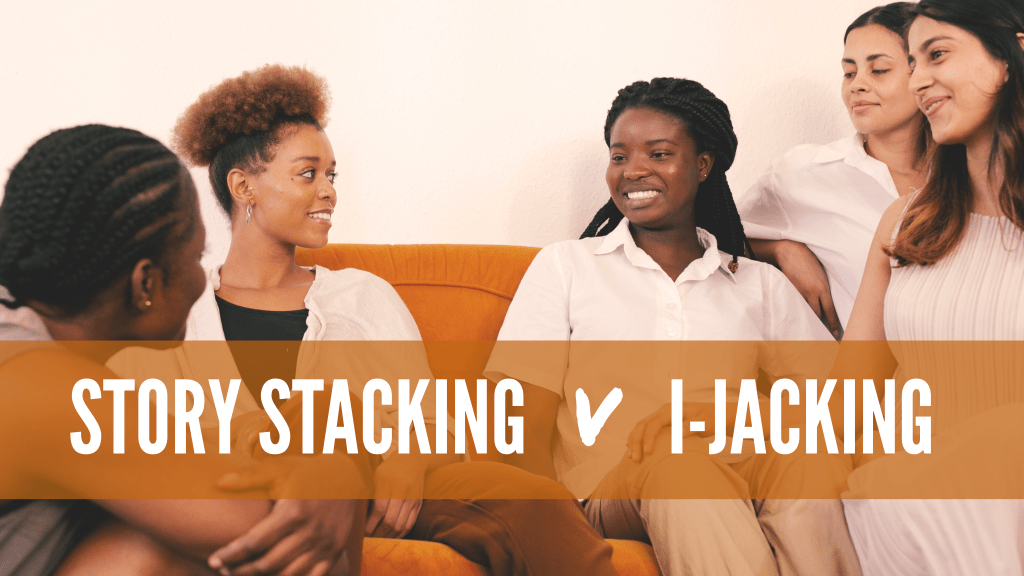Recently, I was having dinner with a group of friends when the conversation led to stories about Zoom. One person recounted a hilarious tale of a woman changing into her pyjamas in full view of the online prayer meeting! And we were away! Each of us was firing off other funny stories we’d seen or experienced. One after the other, not stopping from the laughter of the previous one before the next one began. It was loud and entertaining and our sides hurt from laughing.

This is story stacking and it’s so fun! Whether it’s stories about poo or vomit (everyone has a poo or vomit story!) or sharing favourite ice cream flavours or recalling funny incidents that happened on public transport … the energy is high as stories ping around the group. Each one prompting the recall of another, sometimes with a competitive edge as the tales get taller and more dramatic!
On another occasion, in a group of people, we were talking more seriously about the difference between those people who are expert and highly knowledgeable in their field and those who have the capacity to convey that intelligence to others in helpful ways. I reflected on a really difficult experience I’d had with an ultrasound technician. He had to inform me that I had miscarried early in a pregnancy and he did it in such a cold and callous way. It made an already terrible situation just that little bit harder. Straight away another person jumped to a story of when they needed an X-ray and started to recount their experience.
This is I-jacking. This is when, in response to one person’s sharing, we leap straight away to something that is about us. Or when, no matter the subject of conversation, we manoeuvre the focus back to ourselves or what we want to talk about. Sometimes it’s harmless. It could be an acceptable story stacking situation. But lots of times it’s really unproductive to healthy communication. It can shut someone down. It can dishonor a person’s sharing. It can diminish a person’s experience. It can communicate disinterest in others. It can make you a bad conversationalist! Or, as in my example above, it can actually be quite hurtful. To raise something personal or vulnerable and not have it acknowledged before the conversation moves on to someone or something else.
Story stacking or I-Jacking. One can draw all present into a dynamic social interaction. And the other? Well, that makes you a less appealing conversation partner and is probably not you putting your best foot forward relationally.
So, the trick is knowing how to spot a story stacking moment and how to avoid I-jacking (intentionally or otherwise). It’s a nuanced business but, generally, a story stacking moment is about light hearted or objective things. Like funny Zoom stories or tales of wardrobe malfunctions. If the topics are more personal, deep or reflective, or are initiated by the serious questioning of someone in the group – that’s not the time for story stacking. We must hold space for an individual to share fully and be responded to appropriately.
Story stacking is possibly the one sport I could medal in at an Olympic level! I love it! I love hearing other people’s fun stories. I have so many great stories (that I often forget about until someone else shares and prompts a memory) and I love me a good story tell! And then I love – perhaps the most – how my storytelling might prompt someone else to contribute and get to participate in the “collective effervescence” of a group deep in storytelling mode. But I recognise (first in others which made me question it in myself) that story stacking can so easily come across as I-Jacking if the initial story teller was hoping for the chance to say more or go deeper. It looks like attention stealing. It looks like disrespect. It can communicate a lack of welcome or inclusion.
ASK ONE QUESTION!
This is my social trigger, the mantra I’m repeating (or at least trying to remember to repeat) in my head while you’re speaking. Don’t jump straight in with an anecdote or a solution or a story of my own. Hold the space for the speaker just a little longer. “When did that happen?” “Why is that?”“How do you feel about that?” “What happened next?” “Does anyone have this on video?”
So often, when we are listening to others speak we’re looking for points of intersection. We are naturally wired to desire inclusion and connection so we’re trying to find our place in the topic that’s being discussed. Someone says “I really loved my holiday in Italy!” And our first thought might be to say “oh, I went there in 2019!” or, alternatively, to immediately highlight the disconnect “yeah, I’ve never been to Europe” or perhaps even more tempting “oh, I’ve been there twice now!”. In any of those responses, we’ve just made the conversation about us.
Ask one question. It’s a form of social discipline to train ourselves to stay with the speaker just that little bit longer – to value them, to learn about them, to be equipped to understand them better. Often, in the speaker’s response to that second opportunity you can gauge how desiring they are of a further chance to engage or how willing (or hopeful) they are for the conversation to bounce on around the group.
Story stacking or I-jacking. Watch for it around you, watch for it in you. Becoming more alert to the more appropriate conversation genre will increase your social intelligence and make sure you’re the one people want to be seated next to at the dinner parties!

Hi Kim,
I love the way you have explained this topic and revealed your passions and delights and care.
Much resonance.
With love, Connie
Connie Janssen
conniejanssen19@gmail.com +61 408 484 155
>
LikeLiked by 1 person